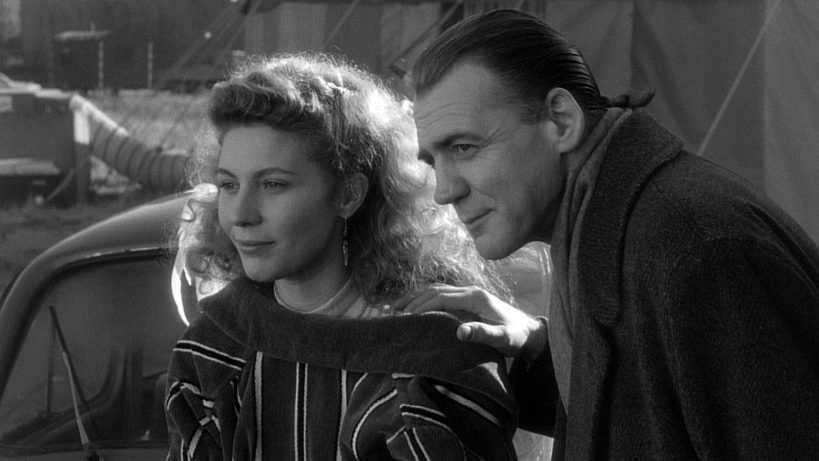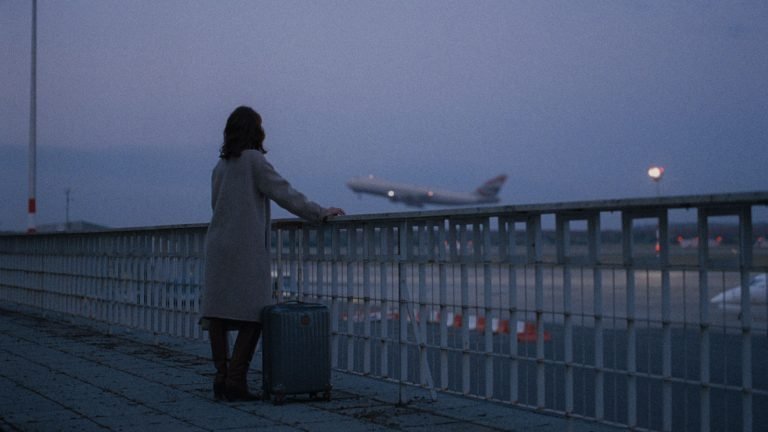
Wings of Desire
(dir. Wim Wenders, 1987)
- Published on February 17, 2019
- by Igor Fishman
Wings of Desire has been sitting in my watchlist for so long that there was a thought that maybe it would be one of those films that I would never get around to. However, earlier this weekend after hearing the sad news of Bruno Ganz passing and remembering this film, I committed myself to finally ‘take the plunge’. I expected it to be great, after all, it is a universally beloved work from the director of the critically adored Paris, Texas. However, it was the immediate visceral impact of its imagery, the poetry of its script, and Ganz’s soulful performance truly astounded me.
Director Wim Wenders took inspiration from the architecture of his home city of Berlin where angel statues appear everywhere, as well as the poetry of Rilke to conceive of this masterpiece. The basic plot of which is that of two angels watching over the earth and one of them begins to fall in love with a woman, yearning to become human. What follows is a poetic meditation on faith, the power of cinema, and a mournful examination of a Berlin in the midst of the Cold War.
The film opens on an image of an eye, and much like the very best directors Wenders keenly channels the relationship of the viewer to the screen as he begins. It reminds me of the opening of Persona, the projector rattling to life, a boy presses his hand against a screen projecting the first images of the film itself. Just like in Persona, here we awaken into a character’s vision, we essentially embody the angel played by Bruno Ganz who watches over the city with his partner. The camera glides through the skies over Berlin, and in these moments, the city becomes our home as well.

As we make our way to the streets below, we pass through the lives of a dozen individuals across the scope of the entire city. Each individual’s thoughts speak out like poetry, a never-ending stream of human consciousness flowing in currents. Passing through the library we see other angels acknowledge us, we are separate from these worlds, and yet a part of the city ourselves. We fly up to the higher portions of the atmosphere where hear the cacophonous radio towers that stand tall as airplanes pass by, the air is consumed in the continuous torrents of human thought spoken out loud. The depiction of human though like poetry throughout this film seems to make the proposition that human thought has always been poetry.
It’s at this point as the angel moves towards the circus that we encounter the real magic trick that Wenders pulls. While this is one of the oldest tricks in the book, first appearing in Wizard of Oz, it nevertheless never loses its power. As we enter the circus, and Ganz watches the trapeze artist, played by Solveig Dommartin, the film briefly and momentarily escapes from the Angel’s perspective and switches from the stately black and white to a ravishing color. This we realize, is the actual world as it appears to people, this is the world of the living. What’s fascinating here is that the world of angels is robbed of color, while it exists unnoticed in our mundane reality. It would be as if Dorothy was swept away from a sepia Oz, to return to a Kansas beaming in radiant Technicolor.
This decision makes wonderful sense within the metaphor of cinema itself. Films are able to evoke and express a multitude of spectacularly poetic vistas, and yet the limitations of the screen remain. That screen can never capture the infinite range of the mundane that we take for granted. I think at one time or another, each of us has experienced the feeling of walking out of a dark movie theater into a bright sunny day and being jarred awake by the reality of the city or world that we are returning into. This feeling of novelty disappears in a matter of seconds and life returns to normal, but for a few seconds, the world can feel magical.

In a foreword to a book on her films, Wenders himself admits how absolutely integral Claire Denis, who was assistant director on this film, was in making both Paris, Texas and Wings of Desire. Wenders writes: “My own guardian angel on this film was Claire. She was both the assistant in the American sense…that she would lead the shoot like a military operation, and in a more European tradition she shared all creative issues, fears, and dreams with me.” I have not even written ten pieces for the site yet, and this is already the third time that Claire Denis appears here. I wrote about her fantastic Let the Sunshine In in my Top Ten of 2018 list, as well as my favorite of hers, 35 Shots of Rum which is featured in this post.
In fact, it would be Denis who would come up with the idea to cast none other than Peter Falk, literally playing himself, an actor on a film set in West Berlin. The film being shot is a detective story taking place during the war. The film set becomes the microcosm of the film. The shoot takes place in a dilapidated building where the floor has given out, the director looks down to the lower floors like the angels gazing from the heavens. On the far wall at the end of the shot, the Nazi flag hangs, an ever-present reminder of the horrors that humanity is capable of. In much the same way, Wenders shows an old man speaking of the past, in his poetic reminiscences, the man speaks of immortalized war epics, and asks: Where are the heroes of peace? What is it about peace that its inspiration is not enduring?
The question hangs over the film, as we see more images of the war, and the constant presence of the Berlin Wall, which would come down a couple of years after the release. In many ways, the angels, and in their metaphoric place, cinema itself is presented as the possible hero, the driver of empathy. We see Ganz’s partner angel, played by Otto Sander attempt and fail to soothe a suicidal young man. The angel howls out in pain as the man jumps to his death, and then attempts to follow suit.

If anything, these angels represent not only a passive cinematic gaze but the emotional resonance that trails it. So much of this resonance is grounded in Bruno Ganz’s beautifully delicate performance. It’s hard to overstate what a tightrope this role must have been, as it relies on the angels to react in a quiet solitude through facial expressions alone. With each touch, either of the hand or on the shoulder represents both a balm for the individual, as well as a clearer empathetic transfer for the angel.
Ultimately, it’s the words of an actor, Falk, that pushes our angel to commit to starting life anew as a human. We later learn that Falk himself is a fallen angel, and mentions that there are many more who have come down. The angelic armor traded away, the symbol of protection, vulnerability is shown as the hallmark of humanity. These are the heroes of peace, laying down the arms. In this, Wenders puts forward a vision of Germany laying aside the thorny vestiges of war and stepping forward into a peaceful future.
One of the most fascinating choices in a film full of remarkable decisions is the way in which the two lovers finally meet. As expressed in a gorgeous monologue delivered by Solveig Dommartin, the decision to love one another is an embodiment of so much more, it is as if the world is watching. As these words are delivered it’s hard not to think about the world with its eyes keenly on Berlin throughout the eighties. As well as the metaphor of cinema, these characters have already been united by the connective tissue of the shared dream space, one sits in the stands and the other performs on stage, it makes perfect sense for the film to end with the fourth wall crumbling down.
Where to stream: Amazon, Google Play, iTunes
Additional Materials: Opening of Persona, Rilke’s Poetry


‘Lapsis’ Review: Skewering the Gig Economy
Noah Hutton’s sci-fi satire Lapsis may stumble at times, but its punchy riffs on the gig economy make it worth a look.

‘Just Don’t Think I’ll Scream’ Review
(link to theQuietus.com)
A staggering work that uses clips from over 400 films to tell a personal story about cinephilia, alienation, and loss, while speaking directly to our anxious moment. Read my review in The Quietus.

‘Preparations to be Together for an Unknown Period of Time’ Review
(link to UltraDogme.com)
A Sylvia Plath poem comes to life in this meditation on loneliness, infatuation, and love as it exists in our inner worlds. Read my review at Ultra Dogme.

‘Some Kind of Heaven’ Review
(link to InReviewOnline.com)
Equal parts Errol Morris and David Lynch, this oddball journey through the world’s largest retirement community reveals a startling portrait of American alienation. Read my review at In Review Online.

The Ten Best Films of 2020
With 2020 finally drawing to a close, lets take one last look at the wonderful films that came out in this otherwise devastating year.

‘Black Bear’ Review: Aubrey Plaza’s Time to Shine
Aubrey Plaza shows off her considerable talents and range, overcoming a messy script to once again prove her mettle as a formidable dramatic lead.
